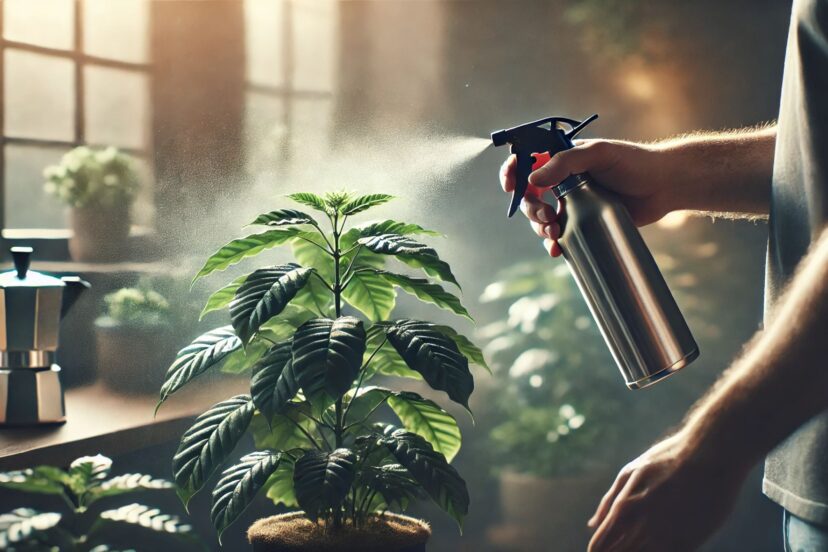Coffee Plant Care: How To Grow Your Coffee Plant Indoors
*We may earn a commission for purchases made using our links. Please see our disclosure to learn more.
Growing a coffee plant indoors can be tricky. You might struggle with wilting leaves, slow growth, or even plant death. Coffee Plant Care doesn’t have to be a mystery, though. With the right knowledge, you can nurture a thriving indoor coffee plant.
Did you know that coffee plants can live for over 100 years in the wild? While your indoor plant may not reach that age, proper care can keep it healthy for decades. This guide will walk you through the essentials of Coffee Plant Care, from ideal growing conditions to daily maintenance.
Ready to become a coffee plant expert?
Key Takeaways
- Coffee plants need bright, indirect light for 4-6 hours daily, with ideal temperatures between 65°F and 80°F.
- Use slightly acidic (pH 6.0-6.5) peat-based potting soil with good drainage for indoor coffee plants.
- Water deeply when the top 25% of soil is dry, typically once a week, and fertilize every two weeks from March to October.
- Watch for pests like mealybugs and aphids, treating with organic options such as insecticidal soap or neem oil.
- Address browning leaves by improving air flow, adjusting light exposure, and avoiding overwatering to keep plants healthy.
Optimal Growing Conditions for Indoor Coffee Plants
Indoor coffee plants thrive in specific conditions. You need to create the right environment for your plant to flourish.
Light Requirements
Coffee plants thrive in bright, indirect light. You’ll want to place your indoor coffee plant near an east or west-facing window. This spot gives your plant the right amount of light without exposing it to harsh direct sunlight.
Too much direct sun can harm your coffee plant, causing its leaves to brown and crisp.
For the best growth, aim for 4-6 hours of filtered sunlight daily. If your home doesn’t get enough natural light, you can use grow lights to supplement. Just make sure to keep the lights a few feet away from your plant to avoid leaf burn.
With the right light setup, your indoor coffee plant will flourish and maybe even produce some beans one day!
Ideal Temperature Range
Your indoor coffee plant thrives in a cozy environment. Keep the temperature between 65°F and 80°F for the best results. During the day, aim for 70°F to 80°F to mimic its natural habitat.
At night, let it cool down slightly to 65°F to 70°F. This range helps your plant grow strong and healthy.
Watch out for extreme heat, as it can stress your coffee plant. If outdoor temps climb above 86°F, bring your plant inside. This move protects it from heat damage and keeps it in its comfort zone.
By maintaining these ideal temps, you’ll create a perfect home for your indoor coffee companion.
Soil Composition
Coffee plants thrive in rich, peat-based potting soil with excellent drainage. You’ll want to use a mix that’s slightly acidic, with a pH between 6.0 and 6.5. This acidic environment mimics the natural habitat of coffee plants and helps them absorb nutrients effectively.
Your indoor coffee plant will flourish in a growing medium packed with organic matter. A nutrient-rich soil composition supports healthy root development and overall plant growth. Make sure to choose a potting mix that balances moisture retention with good drainage to prevent root rot.
This ideal soil setup will give your coffee plant the best chance to grow strong and produce those aromatic leaves you love.
Daily Care and Maintenance
Daily care keeps your indoor coffee plant thriving. Regular watering and feeding will help your plant grow strong and healthy.
Watering Needs
Proper watering is key to keeping your coffee plant happy. You’ll need to water deeply to moisten the soil, then wait until it’s dry halfway down before watering again. This usually means watering once a week if your plant gets good light.
Keep the soil evenly moist but not soggy. Avoid letting it dry out completely.
Check your plant’s soil regularly to gauge moisture levels. Water when about 25% of the soil feels dry to the touch. This helps maintain the right balance of hydration for healthy growth.
Adjust your watering schedule based on your home’s conditions and your plant’s needs. Next, let’s look at how to fertilize your indoor coffee plant.
Fertilization Schedule
Your coffee plant needs regular feeding to thrive indoors. Feed your plant every two weeks from March to October with a diluted liquid fertilizer. Use a balanced 10-10-10 mix to give your plant the right nutrients.
In winter, cut back to once a month to match the plant’s slower growth. This schedule keeps your coffee plant healthy and strong year-round.
Proper nutrition is key to your plant’s success. Stick to this feeding plan, and you’ll see your coffee plant flourish. The next step in caring for your indoor coffee plant involves daily care and maintenance.
Troubleshooting Common Issues
Even the most well-cared-for coffee plants can face issues. You might spot pests or notice your plant’s leaves turning brown.
Managing Pests
Coffee plants can fall prey to pesky invaders like mealybugs, aphids, and mites. You’ll spot these troublemakers by the tiny webs or clumps of white powder they leave behind. Don’t worry, though! You can fight back with organic weapons.
Grab some insecticidal soap or neem oil to treat infestations without harsh chemicals. These natural options pack a punch against pests while keeping your coffee plant healthy.
Regular checks are key to catching problems early. Look closely at your plant’s leaves and stems each week. If you see any signs of pests, act fast! Wipe down leaves with a damp cloth to remove bugs and their eggs.
For tougher cases, spray your plant with your chosen organic pesticide. Stay on top of pest control, and your indoor coffee plant will thrive. Now, let’s move on to another common issue: addressing browning leaves.
Addressing Browning Leaves
Brown leaves on your coffee plant can signal various issues. Fungal diseases like leaf spot often cause brown spots. To fix this, remove affected leaves and improve air flow around your plant.
If entire leaves turn brown and fall off, your plant might suffer from leaf scorch. Moving it to a spot with more indirect light can help. Overwatering is another common culprit for brown leaves.
Check your soil drainage and adjust your watering schedule to prevent waterlogged roots.
You can tackle most browning leaf problems with simple changes. For fungal issues, use a fungicide and ensure good air circulation. If sunburn is the cause, gradually move your plant to a shadier spot.
Always check the soil moisture before watering. Let the top inch of soil dry out between waterings to avoid root rot. With these steps, you’ll keep your coffee plant’s leaves green and healthy.
Conclusion
Growing coffee plants indoors can be a rewarding hobby. With the right care, your coffee plant will thrive and might even produce beans. Provide your plant bright, indirect light and keep the soil moist.
Monitor for pests and address any issues promptly. Your indoor coffee plant will bring a touch of nature to your home and potentially a fresh cup of joe in the future.
FAQs
1. How often should I water my indoor coffee plant?
Water your coffee plant when the top inch of soil feels dry. These plants prefer consistent moisture but not soggy soil. Typically, this means watering once or twice a week, adjusting based on your home’s humidity and temperature.
2. What light conditions do indoor coffee plants need?
Coffee plants thrive in bright, indirect light. Place them near a window that receives filtered sunlight. Avoid direct afternoon sun, which can scorch the leaves. If natural light is limited, use grow lights to supplement.
3. How can I maintain proper humidity for my coffee plant?
Coffee plants prefer high humidity. Boost moisture levels by misting the leaves daily, using a pebble tray filled with water, or placing a humidifier nearby. Grouping plants together also helps create a more humid microclimate.
4. What type of soil and fertilizer work best for indoor coffee plants?
Use well-draining, slightly acidic soil for your coffee plant. A mix of peat moss, perlite, and loam works well. Feed your plant with a balanced, water-soluble fertilizer every two weeks during the growing season, reducing to monthly in winter.




